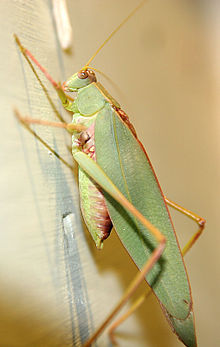Ensifera
| Ensifera | |
|---|---|

| |
| Abush cricket or katydid | |
| Scientific classification | |
| Domain: | Eukaryota |
| Kingdom: | Animalia |
| Phylum: | Arthropoda |
| Class: | Insecta |
| Order: | Orthoptera |
| Suborder: | Ensifera |
| Superfamilies and families | |
|
See text | |
Ensiferais asuborderofinsectsthat includes the various types of crickets and their allies including:true crickets,camel crickets,bush crickets or katydids,grigs,wetaandCooloola monsters.This and the suborderCaelifera(grasshoppers and their allies) make up the orderOrthoptera.Ensifera is believed to be a more ancient group than Caelifera, with its origins in theCarboniferousperiod,[2]the split having occurred at the end of thePermianperiod.[3]Unlike the Caelifera, the Ensifera contain numerous members that are partially carnivorous, feeding on other insects, as well as plants.
EnsiferisLatinfor "sword bearer", and refers to the typically elongated and blade-likeovipositorof the females.[4]
Characteristics[edit]
Characteristics shared by the two orthopteran suborders, Caelifera and Ensifera, are the mouthparts adapted for biting and chewing, the modified prothorax, the hind legs modified for jumping, the wing shape and venation, and the sound-producing stridulatory organs.[2]
Ensiferans are distinguished from Caeliferans by their elongated, threadlikeantennae,which are often longer than the length of their bodies and have over 30 segments (except in the subterraneanCooloolidaefamily). For this reason, they are sometimes referred to as "long-horned orthopterans". In the families in which the males sing, the fore wings have modifications that include toothed veins and scrapers for making the noise, and the surrounding membranous areas amplify the sound. In these groups, the sound-detectingtympanal organsare located on the tibiae of the front legs.[5]The tarsi have three segments and theovipositoris blade-like or needle-like. The male attaches thespermatophoreexternally to the female'sgonopore.The spermatophore is often surrounded by aproteinaceousspermatophylax,the function of which is to provide a nutritionalnuptial giftto the female.[5][6]
Taxonomy[edit]




The Orthoptera Species File database lists the following superfamilies and families.[7]
- Infraorder †Elcanidea
- Superfamily †Elcanoidea
- Family †Elcanidae(Late Triassic - Paleocene)
- Family †Permelcanidae(Early Permian - Late Triassic)
- Superfamily †Permoraphidioidea
- Family †Permoraphidiidae(Permian)
- Family †Pseudelcanidae(Early Permian)
- Family †Thueringoedischiidae(Early Permian)
- Familyincertae sedis
- Genus †AcridiitesHeer, 1865
- Superfamily †Elcanoidea
- InfraorderGryllidea
- SuperfamilyGrylloidea
- Family †Baissogryllidae
- FamilyGryllidae- true crickets
- FamilyMogoplistidae- scaly crickets
- FamilyPhalangopsidaeBlanchard, 1845
- Family †ProtogryllidaeZeuner, 1937
- FamilyTrigonidiidaeSaussure, 1874
- SuperfamilyGryllotalpoideaLeach, 1815[8]
- FamilyGryllotalpidaeLeach, 1815– mole crickets
- FamilyMyrmecophilidaeSaussure, 1874- ant crickets
- SuperfamilyGrylloidea
- Infraorder †Oedischiidea
- Superfamily †OedischioideaHandlirsch, 1906
- Family †AnelcanidaeCarpenter, 1986
- Family †BintoniellidaeHandlirsch, 1939
- Family †MesoedischiidaeGorochov, 1987
- Family †OedischiidaeHandlirsch, 1906
- Family †ProparagryllacrididaeRiek, 1956
- Family †PruvostitidaeZalessky, 1929
- Familyincertae sedis
- Genus †CrinoedischiaBéthoux & Beckemeyer, 2007
- Genus †LoxoedischiaBeckemeyer, 2011
- Superfamily †TriassomantoideaTillyard, 1922
- Family †AdumbratomorphidaeGorochov, 1987
- Family †TriassomantidaeTillyard, 1922
- Superfamily †XenopteroideaRiek, 1955
- Family †XenopteridaeRiek, 1955
- Superfamilyincertae sedis
- family †PermotettigoniidaeNel & Garrouste, 2016
- Familyincertae sedis
- Genus †PermophyllumProkop,et al,2015
- Superfamily †OedischioideaHandlirsch, 1906
- InfraorderTettigoniidea
- SuperfamilyHagloidea- grigs
- Family †EospilopteronidaeCockerell, 1916
- Family †HaglidaeHandlirsch, 1906
- Family †HagloedischiidaeGorochov, 1986
- Family †PrezottophlebiidaeMartins-Neto, 2007
- FamilyProphalangopsidaeKirby, 1906
- Family †TuphellidaeGorochov, 1988
- Superfamily †PhasmomimoideaSharov, 1968
- Family †PhasmomimidaeSharov, 1968
- SuperfamilyRhaphidophoroideaWalker, 1869
- FamilyRhaphidophoridaeWalker, 1869- camel crickets, cave crickets, cave weta
- SuperfamilySchizodactyloideaBlanchard, 1845
- FamilySchizodactylidaeBlanchard, 1845- dune or splay-footed crickets
- SuperfamilyStenopelmatoideaBurmeister, 1838
- FamilyAnostostomatidaeSaussure, 1859- weta (except cave weta), king crickets
- FamilyCooloolidaeRentz, 1980- Cooloola monsters
- FamilyGryllacrididaeBlanchard, 1845- leaf-rolling crickets
- FamilyStenopelmatidaeBurmeister, 1838- Jerusalem crickets
- SuperfamilyTettigonioideaKrauss, 1902
- Family †HaglotettigoniidaeGorochov, 1988
- FamilyTettigoniidaeKrauss, 1902- bush crickets, katydids, koringkrieks
- SuperfamilyIncertae sedis
- Familyincertae sedis
- Genus †TettoraptorGorochov, 2012
- Familyincertae sedis
- SuperfamilyHagloidea- grigs
- Infraorderincertae sedis
- Superfamily †GryllavoideaGorochov, 1986
- Family †GryllavidaeGorochov, 1986
- Superfamily †GryllavoideaGorochov, 1986
- SuperfamilyIncertae sedis
- Family †Palaeorehniidae(syn "Zeuneropterinae")[9]
- Family †Vitimiidae
Phylogeny[edit]

Thephylogenetic relationshipsof the Ensifera, summarized by Darryl Gwynne in 1995 from his own work and that of earlier authors,[a]are shown in the followingcladogram,with the Orthoptera divided into two main groups, Ensifera andCaelifera(grasshoppers). Fossil Ensifera are found from the lateCarboniferousperiod onwards.[5][10]
The oldest known fossil in theArchaeorthoptera,thecrown groupof the Orthoptera, and also the oldest member of thePterygota(winged insects), is from theNamurian(324 mya) Lower Carboniferous beds in the Upper Silesian Basin of the Czech Republic.[11]
| Orthoptera |
| |||||||||||||||||||||||||||||||||||||||
Notes[edit]
References[edit]
- ^Wang, Yan-hui; Engel, Michael S.; Rafael, José A.; Wu, Hao-yang; Rédei, Dávid; Xie, Qiang; Wang, Gang; Liu, Xiao-guang; Bu, Wen-jun (2016)."Fossil record of stem groups employed in evaluating the chronogram of insects (Arthropoda: Hexapoda)".Scientific Reports.6:38939.doi:10.1038/srep38939.PMC5154178.PMID27958352.
- ^abResh, Vincent H.; Cardé, Ring T. (2009).Encyclopedia of Insects.Academic Press. pp. 232, 733–735.ISBN978-0-08-092090-0.
- ^Zeuner, F. E. (1939).Fossil Orthoptera Ensifera.London: British Museum Natural History.
- ^"Orthoptera".Natural History Museum.Retrieved2015-05-13.
- ^abcGwynne, Darryl T.; DeSutter; Laure (1996)."Ensifera: Crickets, katydids and weta".TOLweb.Retrieved8 May2015.
- ^Vahed; K. (1998)."The function of nuptial feeding in insects: review of empirical studies"(PDF).Biological Reviews.73:43–78.doi:10.1111/j.1469-185X.1997.tb00025.x.S2CID86644963.Archived fromthe original(PDF)on 2012-03-11.Retrieved2015-05-08.
- ^"Suborder Ensifera".Orthoptera Species File.Retrieved9 May2015.
- ^Orthoptera Species File (Version 5.0/5.0)
- ^Archibald, S. B.; Gu, J.-J.; Mathewes, R. W. (2022). "The Palaeorehniidae (Orthoptera, Ensifera," Zeuneropterinae "), and new taxa from the early Eocene Okanagan Highlands, western North America".Zootaxa.5100(4): 559–572.doi:10.11646/zootaxa.5100.4.6.
- ^abGwynne, Darryl T. (1995). "Phylogeny of the Ensifera (Orthoptera): a hypothesis supporting multiple origins of acoustical signalling, complex spermatophores and maternal care in crickets, katydids, and weta".Journal of Orthoptera Research.4(4): 203–218.doi:10.2307/3503478.JSTOR3503478.
- ^Prokop, Jakub; Nel, André; Hoch, Ivan (2005). "Discovery of the oldest known Pterygota in the Lower Carboniferous of the Upper Silesian Basin in the Czech Republic (Insecta: Archaeorthoptera)".Geobios.38(3): 383–387.doi:10.1016/j.geobios.2003.11.006.
